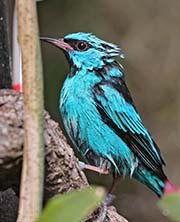Blue Dacnis - Dacnis cayana
| Length | |
| Weight | |
| Clutch Size | |
| Chicks at birth | |
| IUCN Conservation Status | |
Continents: |
Blue Dacnis is a member of the tanager family and eight subspecies of them are found in South America. It was formerly call the turquoise Honeycreeper, but since it is not a honeycreeper, the name is no longer used. It is widespread and common in its range.
Blue Dacnis are sexually dimorphic. The male is turquoise with a black throat, black back, and black around the eyes. The wings are black and are edged with turquoise. The female body is mostly green. The wings are green and brown, the head is blue, and the eyes are dark. The beak is pointed and mostly dark but lightens to a pinkish color at the base. The coloration of the various subspecies may vary.
Diet: Blue Dacnis forage in tree tops and eat insects, fruit and nectar. To get the insects, they will hang on twigs and lean over or hang upside down to get the insects from the leaves.
Courtship: Males courtship behavior includes moving restlessly from branch to branch and standing tall and bowing. They also will engage in nuptial feeding.
Nesting: The female Blue Dacnis build a bulky cup-shaped nest in a tree while the male guards. The nest is composed of compacted fine fibers and seed down. The female lays and incubates 2-3 eggs and both parents feed the young.
Habitat and Range: Blue Dacnis are found from Nicaragua to Panama, on Trinidad, and in South America south to Bolivia and northern Argentina. They prefer forests and other woodlands and will also inhabit gardens and parks.
Vocalization: The Blue Dacnis's call is a thin tsip.
Plumage/Molt: No alternative breeding plumage and molt annually.
Migration: Not migratory.
Tongue/feet: Feet and legs are pinkish.
Bibliography:
- http://en.wikipedia.org The Free Encyclopedia, Accessed June 2012
- http://www.birdforum.net Birdforum: the forum for wild birds and birding, Accessed June 2012
- Isler, Morton L. and Isler, Phyllis R., The Tanagers: Natural History, distribution, and Identification,Smithsonian Institution Press, Washington D.C., 1987








